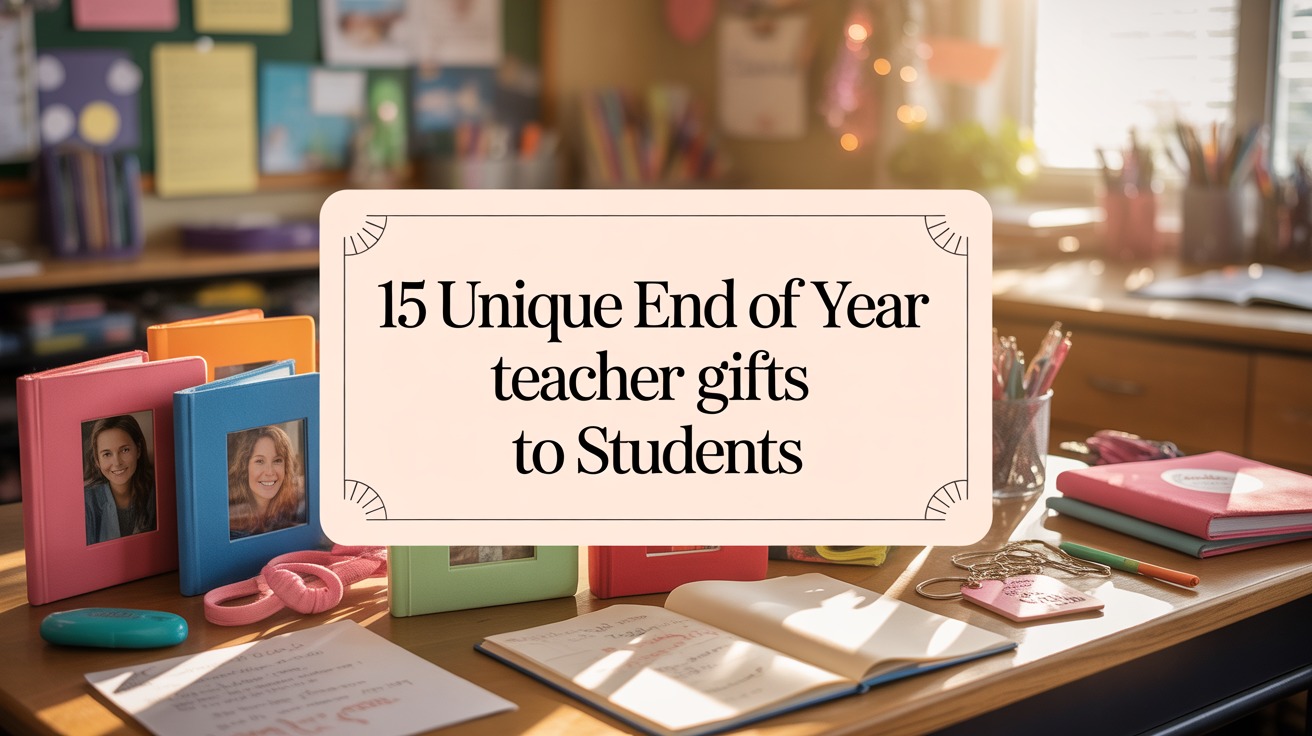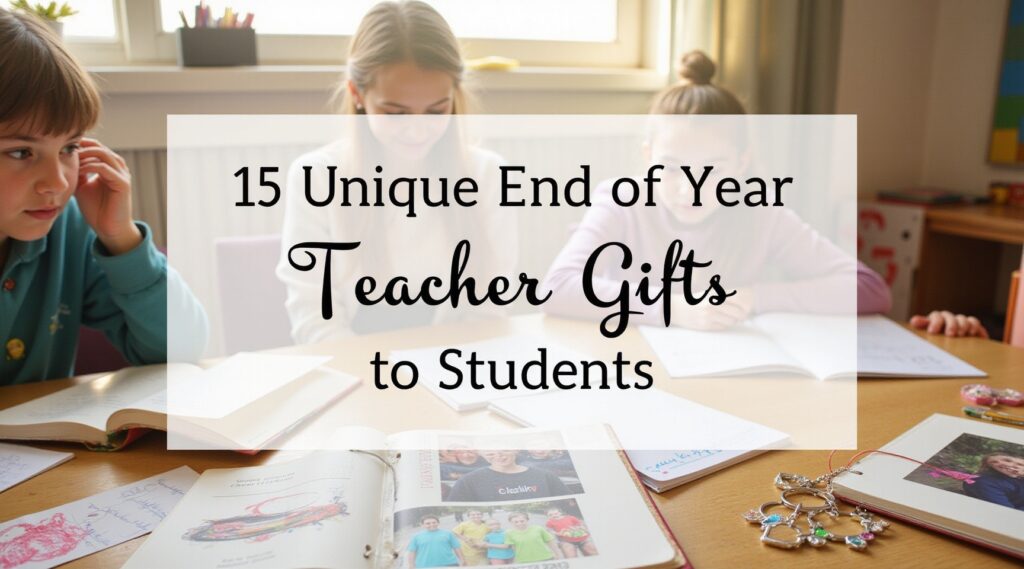
The final bell rings. Students pack their memories alongside textbooks. And you—the educator who shaped their year—stand at the crossroads between goodbye and celebration.
Most teachers receive gifts from grateful families at year’s end. But what about flipping the script? What happens when you become the gift-giver, creating moments that students will remember long after they’ve forgotten logarithms and Shakespeare quotes?
Smart teachers know that meaningful gestures don’t require big budgets. They require heart, creativity, and a dash of strategic thinking about what truly matters to young minds preparing to step into summer—or their next chapter entirely.
Why Teachers Give Back
The tradition of educator-to-student gifting reflects something deeper than seasonal courtesy. Research from the American Educational Research Association shows that positive teacher-student relationships significantly impact academic achievement and emotional development. A small, thoughtful gift becomes a tangible reminder of that connection.
Consider this: your students spend 180 days in your classroom. They witness your passion, your bad dad jokes, your genuine investment in their success. A carefully chosen end-of-year gift acknowledges that mutual journey while sending them off with something concrete to hold onto.
The psychology behind memorable gifts lies in their ability to represent shared experiences. When done right, these tokens become time capsules—physical objects that instantly transport recipients back to formative moments.
15 Thoughtful End-of-Year Student Gifts
1. Custom Graduation Embroidered Sweatshirts or Hoodies
Nothing says “we did this together” quite like matching graduation sweatshirts and hoodies featuring your class year and a meaningful phrase. Picture the Instagram moments when your former students reunite years later, all sporting the same “Class of 2024: Dream Builders” hoodie.
The beauty of custom embroidered apparel lies in its dual purpose: immediate group identity and long-term keepsake. Choose colors that reflect your school or classroom theme. Add inside jokes that only your students will understand. Make it personal enough that wearing it feels like being part of an exclusive club.
Pro tip: Order in various sizes to accommodate growth spurts. Nothing saddens a seventh-grader more than outgrowing their favorite memento by ninth grade.
2. Handwritten Letters Sealed for the Future
Type less. Write more. In our digital age, handwritten notes carry unusual weight. Craft individual letters highlighting each student’s growth, memorable classroom moments, and your genuine hopes for their future.
Present these letters in decorative envelopes marked with instructions: “Open when you need encouragement” or “Read on your 18th birthday.” Students may roll their eyes initially, but they’ll treasure these time capsules when life gets complicated.
3. DIY Memory Jars
Fill mason jars with colorful paper strips containing class inside jokes, memorable quotes from throughout the year, and encouraging affirmations specific to each student. Include photos from field trips, classroom celebrations, or candid learning moments.
Students can draw from their jar whenever they need a smile. The random nature makes each memory rediscovery feel like a pleasant surprise.
4. Personalized Achievement Certificates
Move beyond generic award templates. Design certificates recognizing unique qualities: “Master of Asking Thoughtful Questions,” “Champion of Helping Others,” or “Curator of Creative Solutions.”
Focus on character traits and effort rather than just academic performance. Some of your greatest classroom contributors might not be your highest test scorers.
5. Class Recipe Book
Compile favorite recipes shared throughout the year—whether from cultural heritage projects, holiday celebrations, or simple snack sharing. Add your own family recipes with notes explaining why you chose to share them.
Food connects us across cultures and generations. This gift gives students a literal taste of their classroom community to recreate at home.
6. Customized Bookmarks
Partner with your school librarian to create bookmarks featuring inspiring quotes, reading recommendations specific to each student’s interests, and space for them to track their summer reading adventures.
Include QR codes linking to digital reading lists or online book club discussions your students can join over the break.
7. Growth Timeline Posters
Create visual timelines showing each student’s academic and personal growth throughout the year. Include photos from September alongside May versions, highlighting specific achievements and moments of breakthrough.
Students often forget how much they’ve changed in just nine months. This visual reminder reinforces their capability for growth.
8. Custom Playlist Cards
Curate Spotify playlists reflecting your classroom’s musical journey—songs you played during work time, tracks that became unofficial classroom anthems, or music connected to your curriculum.
Include QR codes and handwritten notes explaining song choices. Music triggers powerful memories, making this gift particularly evocative years later.
9. Thinking of You Postcards
Pre-address postcards to each student’s home address. Throughout the summer, send quick notes celebrating new adventures, sharing interesting articles related to their interests, or simply letting them know you’re thinking of them.
The surprise factor amplifies the impact. Students don’t expect summer communication from teachers.

10. Life Skills Starter Kits
Assemble small bags containing items that support independence: colorful pens for note-taking, a small calendar for organization, healthy snacks, and a pocket-sized notebook for capturing thoughts and ideas.
Include instruction cards for basic life skills—how to write a professional email, tips for time management, or strategies for handling stress.
11. Classroom Plant Adoptions
Allow students to “adopt” classroom plants, taking them home with care instructions and growth tracking sheets. Plants symbolize growth, responsibility, and the ongoing nature of learning.
Some students have never successfully kept anything alive. This gift offers a low-stakes opportunity to build nurturing skills.
12. Digital Photo Albums
Compile classroom photos into small printed albums or digital slideshows. Organize chronologically or thematically—field trips, project presentations, candid learning moments, and celebration snapshots.
Include captions with context students might forget: “The day Marcus finally understood fractions” or “Sarah’s breakthrough poetry reading.”
13. Community Connection Cards
Research local opportunities matching each student’s interests—summer camps, volunteer organizations, library programs, or hobby groups. Present these as beautifully designed cards with contact information and personal recommendations.
This gift extends learning beyond your classroom while showing students you see their individual potential in the broader community.
14. Gratitude Journals
Provide small journals with prompts encouraging reflection on positive aspects of each day. Include examples of gratitude practices and explain the mental health benefits of regular appreciation exercises.
Students experiencing challenging home situations particularly benefit from tools that help identify bright spots in difficult circumstances.
15. Future Self Letters
Guide students in writing letters to their future selves, then collect and promise to mail these letters in one year. Provide prompts about current goals, favorite subjects, friendships, and hopes for the coming year.
Receiving their own words twelve months later creates a powerful moment of reflection and often pleasant surprise at their growth.
Budget-Conscious Strategies
Meaningful gifts don’t require significant financial investment. Partner with parent volunteers for bulk purchasing power. Apply for small education grants specifically designed for student recognition activities. Many local businesses offer educator discounts for classroom-related purchases.
Consider gift-making as a final classroom project. Students can create items for younger grades while you prepare their own surprises. This approach teaches giving while managing costs.
The most impactful gifts often cost less than five dollars but demonstrate genuine thoughtfulness. A carefully chosen student recognition gift that acknowledges individual personality and growth carries more emotional weight than expensive items lacking personal connection.
Personalizing Your Approach
Effective student gifts reflect your unique classroom culture and individual student personalities. The quiet artist needs different encouragement than the class comedian. Your gift choices should demonstrate that you truly see each student as an individual.
Keep simple notes throughout the year about student interests, achievements, and personality quirks. These observations become invaluable when selecting or customizing end-of-year gifts.
Consider cultural sensitivities and family situations. Some students come from backgrounds where receiving gifts feels uncomfortable. Others rarely experience recognition. Adjust your approach accordingly while maintaining equity in gesture size and thoughtfulness.
Creating Lasting Memories
The most successful teacher-to-student gifts share common characteristics: they acknowledge individual growth, reflect shared classroom experiences, and provide ongoing utility or emotional comfort.
Students will lose pencils and outgrow shirts, but they’ll keep items that make them feel seen, valued, and capable. Your gift might be the only positive recognition some students receive during difficult periods in their lives.
Years later, when former students reach out to share college acceptances, career successes, or life milestones, they often mention specific moments when teachers showed faith in their potential. Your end-of-year gift could be one of those pivotal moments.
Making the Moment Count
Gift presentation matters as much as gift selection. Create a ceremony around the giving. Share specific reasons why you chose each item. Allow time for students to appreciate both their gifts and their classmates’ recognition.
Document the moment with photos (following school privacy policies). These images become part of your teaching portfolio and remind you why this profession matters during challenging future moments.
Consider including families in the celebration. Invite parents to a brief presentation ceremony or send photos home showing their children being celebrated for their unique contributions to your classroom community.
The final weeks of school often feel rushed and administrative. Prioritizing time for meaningful gift-giving and recognition reinforces the relational aspects of education that make lasting differences in student lives.
Your investment in end-of-year student gifts pays dividends in strengthened relationships, positive classroom culture memories, and students who carry forward the confidence that comes from being truly seen and valued by a caring educator.
Which of these gift ideas resonates most with your classroom culture? How might you adapt these suggestions to reflect your students’ unique personalities and shared experiences?

